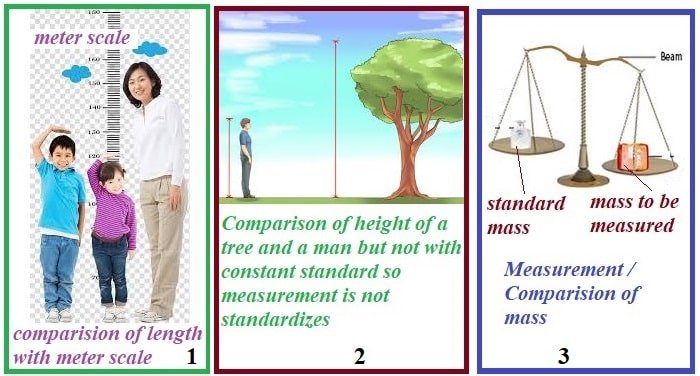Measurement of Physical Quantities
Physical Quantities:
The quantities in terms of which law of physics can be explained, described are called physical quantities.
Physical quantities form the basis of scientific measurement and are essential for describing the properties and behavior of the physical world. Physical quantities are the fundamental building blocks of scientific measurement. Understanding these quantities and their applications is essential for various scientific disciplines and technological advancements. By grasping the concepts of fundamental quantities, derived quantities, and their significance, you can gain a solid foundation in the language of measurement.
Physical quantities are typically classified into two categories:
- Fundamental physical quantities
- Derived physical quantities
Table of Contents
Fundamental physical quantities:
The physical quantities which are independent on any other physical quantities. These serve as the building blocks for deriving other physical quantities. In the International System of Units (SI), there are seven base quantities:
| Sr. No. | Physical quantities | Units | Units Symbol |
|---|---|---|---|
| 1 | Length | meter | m |
| 2 | Mass | kilogram | kg |
| 3 | Time | second | s |
| 4 | Current | ampere | A |
| 5 | Temperature | kelvin | K |
| 6 | Amount of substance | mole | mol |
| 7 | Luminous intensity | candela | Cd |
Mass: Quantity of matter in a body is called mass.
Length: Separation between two points is called length.
Time: Duration between two events is called time.
Temperature: The degree of hotness or coldness of a body.
Current: The rate of flow of charge is called current.
Amount of substance: It measures the number of particles in a substance.
Luminous intensity: It quantifies the intensity of light.
Derived physical quantities:
Those physical quantities which are dependent on any other physical quantities. These quantities are derived from the base quantities and are used to describe more complex aspects of the physical world. Example: Velocity, acceleration, force etc.
Measurement and Units:
The process of comparison of a physical quantity with a constant standard is called measurement, and that constant standards are called Units.
Magnitude of a physical quantity (Q) = Numerical value (N) unit (U)
Numerical value of a physical quantity is inversely proportional to size of its unit.
N̰U = Constant
N1 and N2 are numerical value in unit system one and two; U1 and U2 are unit system one and two.
Q = N1 U1 = N2 U2
Need of Measurement:
Measurement is important in every steps of life. For measurement, each physical quantity is assigned a unit. For example, time could be measured in minutes, hours or days. But for the purpose of useful communication among different people, this unit must be compared with a standard unit acceptable to all. As another example, when we say that the distance between Mumbai and Kolkata is nearly 2000 kilometres, we have for comparison a basic unit in mind, called a kilometre.
Some other units that you may be familiar with are a kilogram for mass and a second for time. It is essential that all agree on the standard units, so that when we say 100 kilometres, or 10 kilograms, or 10 hours, others understand what we mean by them.

In science, international agreement on the basic units is absolutely essential; otherwise scientists in one part of the world would not understand the results of an investigation conducted in another part.
History of Measurement system in India :
Practices of systematic measurement are very old in India. “The king should examine the weights and balance every six months to ensure true measurements and to mark them with royal stamp.” – Manusmriti, 8th Chapter, sloka–403. In Mughal Period, Shershah and Akbar tried to re-establish uniformity of weights and measures. Akbar introduced gaz of 41 digits for measuring length. For measuring area of land, bigha was the unit. 1 bigha was 60 gaz × 60 gaz. Units of mass and volumes were also well obtained in Ayurveda.
Desirable characteristics of a physical Unit:
- It should be well-defined and of convenient size, i.e., neither too small nor too large.
- It should not be affected by the change in physical conditions such as pressure, temperature etc.
- It should be internationally acceptable.
Video Lecture
- This video lecture contains following topics
- Physical quantity – starting to 11.38 min
- What is Measurement? at 11.38 min
- Representation of measurement at 17.23 min
- Why measurement should be standardize? at 25.42 min
- What is need of measurement? at 30.54 min
- History of Measurement system in India at 45.54 min
MY YouTube Channel Link : 👉🖱 https://www.youtube.com/channel/UCGpC7nWE0-bBv9I53MM8qjQ
Measurement of Physical Quantities, Measurement of Physical Quantities, Measurement of Physical Quantities, Measurement of Physical Quantities, Measurement of Physical Quantities, Measurement of Physical Quantities, Measurement of Physical Quantities, Measurement of Physical Quantities, Measurement of Physical Quantities